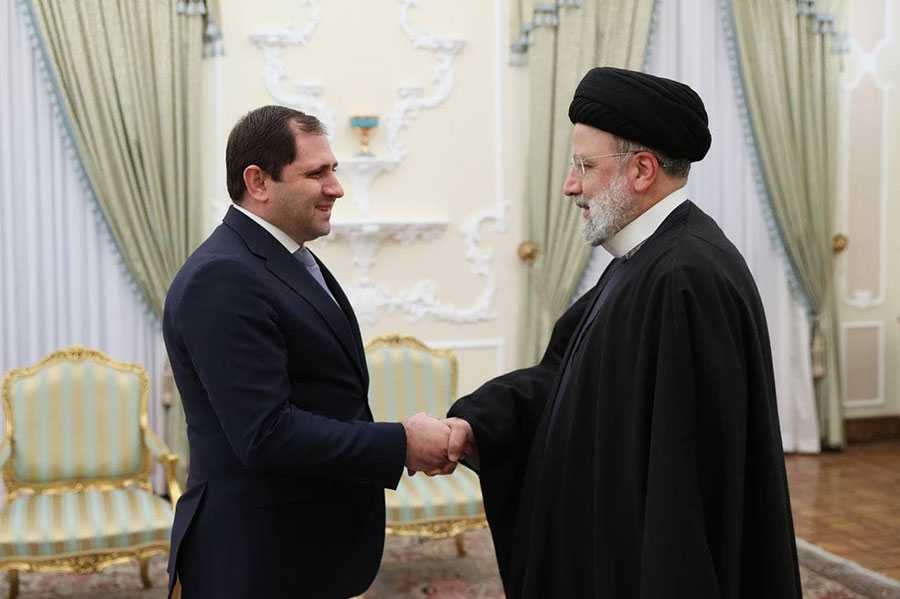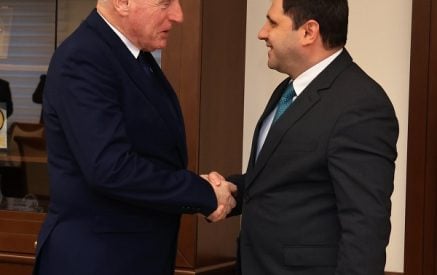by Yeghia Tashjian
Amid increasing tensions between Russia and Armenia, and Azerbaijan’s growing pressure on Armenia to annex new border villages, the first week of March was characterized by intensive official Armenian-Iranian meetings. What is the nature of these meetings? Is there any coincidence with the timing? And what can Iran do to defuse tensions between Yerevan and Moscow?
On March 6, 2024, a delegation headed by Armenia’s Defense Minister Suren Papikyan visited Iran and met with Iranian officials. In Papikyan’s meeting with his Iranian counterpart Brigadier General Mohammad-Reza Ashtiani, the Iranian minister reaffirmed his country’s position supporting Armenia’s territorial integrity and national sovereignty over its entire territory and opposing a change in internationally recognized borders in the region. He also expressed support for direct negotiations between Yerevan and Baku that aim “to bring peace and security to the region.” However, Ashtiani warned that the pursuit of security from outside the region would backfire and create instability, adding, “The architecture of regional security must be formed in the region itself, otherwise it will become a battlefield for major powers.”
Read also
On the sidelines of the official visit, Papikyan also met with Iran’s President Embrahim Raisi. They discussed bilateral cooperation, including in the area of defense. The Iranian president similarly stressed the importance of “the non-interference of outside forces in regional affairs.” President Raisi added that security and peace in the region will be guaranteed only through the cooperation of countries in the region.
Iran has repeatedly sent similar messages to Yerevan over the past several months. Tehran is concerned that Armenian Prime Minister Nikol Pashinyan’s administration is seeking to push Russia out of the region and invite Western mediation. Iran warns that this would trigger a new regional war at its northern border and ultimately pave the way for greater Turkish involvement. Meanwhile, the Armenian Defense Minister said that he has reached “a number of understandings on issues of mutual interest” with the Iranian side, without providing any further details.
Iran has long pushed for a regional format to address the conflict between Armenia and Azerbaijan. In October 2023, Iran’s Foreign Minister Hossein Amir-Abdollahian, while meeting with the secretary of Armenia’s National Security Council Armen Grigoryan, called the 3+3 regional cooperation format (Armenia, Azerbaijan and Georgia, plus Turkey, Russia and Iran) an “effective mechanism to resolve regional issues without the interference of foreign powers.”
Papikyan’s visit was followed by political consultations between the Ministries of Foreign Affairs of Armenia and Iran. On March 9, Armenia’s Deputy Foreign Minister Vahan Kostanyan visited Tehran and was received by Iran’s foreign minister and his deputy Ali Bagheri. They discussed a wide range of issues addressing bilateral relations, regional developments and cooperation within multilateral platforms. Both sides emphasized the importance of regular consultations between the two countries’ foreign ministers and agreed to hold the next round of consultations in Armenia within the next six months.
Iran’s proactive engagement and warning messages to Yerevan should not surprise us. Turkey’s Deputy FM Yasin Ekran Serim, during an official visit to Azerbaijan on March 7, said that “the century of the Turkic world will begin with the opening of the Zangezur corridor under the leadership of Turkey and Azerbaijan.” This was followed by the Azerbaijani Deputy Prime Minister Shahin Mustafayev threatening that Armenia must immediately hand over four villages in the Tavush region to Azerbaijan. The press release from the Azerbaijani official also stated that the fate of the exclave/enclave villages will be decided in the future during the delimitation and demarcation process. Iranian media, Khabaronline.ir, also reported this news and warned of possible escalation along the border near the villages.
Meanwhile, some Russian media outlets expressed curiosity about the content of the official Armenian visits to Tehran. According to Russian outlet IAREX.ru, the visit took place against the backdrop of complicated relations between Yerevan and Moscow and the expansion of Armenia’s military-technical cooperation with the West, particularly with France. IAREX columnist Stanislav Tarasov argued, “Papikyan’s visit to Tehran can be considered mysterious. Yerevan is trying to ‘check the clock’ with Tehran before making any decision.” According to the Russian columnist, this decision is related to the prospects of the Russian military presence in Armenia, in particular the future of the Gyumri military base.
Azerbaijan could take advantage of the fissure between Russia and Armenia and attack and annex Meghri to establish the so-called “Zangezur Corridor,” linking itself with Nakhichevan and Turkey. In such a situation, Tarasov argues that Armenia is trying to utilize Iran’s military and political resources to form a “Caucasian Entente” with the participation of Armenia, France, Greece and India, “directed against Russia and Turkey,” which Iran has no interest in. The Russian expert says that while Iran’s position is clear, opposing “border changes in the region,” Iran is not ready to take Armenia under its “security umbrella” and will not accept a Western umbrella over Armenia. Iran believes that “regional security should be supported by countries in the region, and any approach that contradicts this policy is unacceptable,” and the West should not be “dragged into the region.”
Tasarov’s argument could be shared with Iranian experts. Most experts I have engaged with have demonstrated mistrust toward the current authorities in Armenia; however, they are aware that they have to support Yerevan in order to contain the growing Turkish-Azerbaijani influence in the region. However, the increasing Western involvement in the region, which is expanding via Yerevan, may force Iran to change its calculations towards Armenia and the region.
To defuse tensions, Iran may take three important steps toward Yerevan:
– Establish a trilateral dialogue format between Tehran, Moscow and Yerevan. New Delhi can also be added at a later stage. The main objective of this format would be to defuse tensions between Moscow and Yerevan and push the Armenian authorities to mature diplomatically and calculate the devastating consequences of Russian military withdrawal from Armenia. Both the Armenian and Russian sides should also put an end to the spread of propaganda against each other.
– Deepen ties, hold occasional consultative meetings between Armenia’s defense and foreign ministries, and find ways to coordinate security and defense matters. It is worth mentioning that some Western countries understand Armenia’s needs and the strategic nature of its relations with Iran. Recently, the French ambassador in Armenia remarked that France welcomes Iran’s position in supporting Armenia’s sovereignty and territorial integrity. Iran is actively engaging in maintaining the current status quo to prevent the further expansion of Turkey’s influence to the region, knowing that a new war would deliver another defeat to regionally isolated Armenia and make Turkey the main player in the South Caucasus at the expense of Russia.
– Encourage the Armenian authorities, potentially through India, to apply for observer status in BRICS plus or the Shanghai Cooperation Organization (Armenia became a “dialogue partner” status in SCO in 2016) to integrate Armenia in the regional architecture. By joining such blocs, Armenia’s geo-economic and geopolitical significance will increase in Eurasia, amid rising major powers such as China and India, pushing Russia to positively reconsider its relations with Yerevan. Moreover, convince the current authorities that it is in Armenia’s best interest to remain a member of the Eurasian Economic Union (EAEU) for the moment, as the bloc recently signed a Free Trade Agreement with Iran, and the Armenian economy is benefiting from the incentives provided by the union. Armenia’s value for Iran and India is in its membership to the EAEU. New Delhi is preparing to become an observer country this year and negotiating on the creation of a free trade zone. Yerevan can become a natural bridge between the EAEU and India. Therefore, it is in Armenia’s interest, for the time being, to join major Eurasian integration projects, rather than turning into a “borderline village” of Europe or a proxy battlefield between the West and Russia.























































